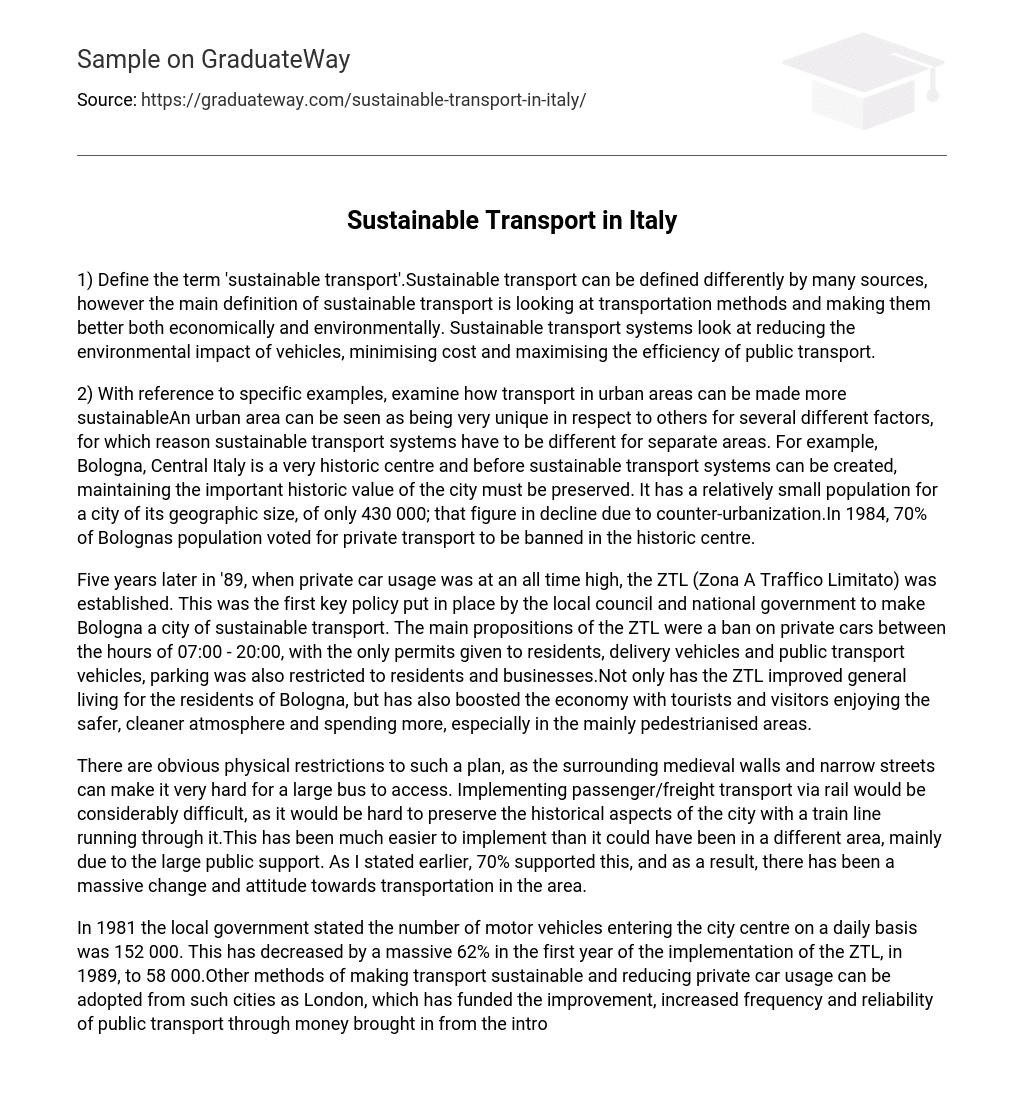1) Define the term ‘sustainable transport’.Sustainable transport can be defined differently by many sources, however the main definition of sustainable transport is looking at transportation methods and making them better both economically and environmentally. Sustainable transport systems look at reducing the environmental impact of vehicles, minimising cost and maximising the efficiency of public transport.
2) With reference to specific examples, examine how transport in urban areas can be made more sustainableAn urban area can be seen as being very unique in respect to others for several different factors, for which reason sustainable transport systems have to be different for separate areas. For example, Bologna, Central Italy is a very historic centre and before sustainable transport systems can be created, maintaining the important historic value of the city must be preserved. It has a relatively small population for a city of its geographic size, of only 430 000; that figure in decline due to counter-urbanization.In 1984, 70% of Bolognas population voted for private transport to be banned in the historic centre.
Five years later in ’89, when private car usage was at an all time high, the ZTL (Zona A Traffico Limitato) was established. This was the first key policy put in place by the local council and national government to make Bologna a city of sustainable transport. The main propositions of the ZTL were a ban on private cars between the hours of 07:00 – 20:00, with the only permits given to residents, delivery vehicles and public transport vehicles, parking was also restricted to residents and businesses.Not only has the ZTL improved general living for the residents of Bologna, but has also boosted the economy with tourists and visitors enjoying the safer, cleaner atmosphere and spending more, especially in the mainly pedestrianised areas.
There are obvious physical restrictions to such a plan, as the surrounding medieval walls and narrow streets can make it very hard for a large bus to access. Implementing passenger/freight transport via rail would be considerably difficult, as it would be hard to preserve the historical aspects of the city with a train line running through it.This has been much easier to implement than it could have been in a different area, mainly due to the large public support. As I stated earlier, 70% supported this, and as a result, there has been a massive change and attitude towards transportation in the area.
In 1981 the local government stated the number of motor vehicles entering the city centre on a daily basis was 152 000. This has decreased by a massive 62% in the first year of the implementation of the ZTL, in 1989, to 58 000.Other methods of making transport sustainable and reducing private car usage can be adopted from such cities as London, which has funded the improvement, increased frequency and reliability of public transport through money brought in from the introduction of congestion charges. The congestion charge is for anyone entering the city centre in a private vehicle.
This is to control and reduce congestion, reduce carbon emissions and get more people using sustainable methods of transport, such as public transport or cycling.3) Suggest reasons why many large urban areas are experiencing transport problems.Obviously large urban areas will have a large population, and with a large population, there needs to be a lot of houses, offices, hospitals, shops, etc. to cope with this.
Space for all these services can be very hard and expensive to obtain within a built up area. This can be a major problem for transport, with there being no space left for new public transport systems to be implemented to cope with the increasing demand for them.This will result in overcrowding of public transport which will in turn lead to unsanitary, dangerous conditions forcing people away from sustainable transport and into cars. This then snowballs into an even larger problem as those who turn toward cars congest all the road networks in and around CBD’s and such places, whilst at the same time contributing heavily towards global warming.
Tokyo is an extreme example of this, with congestion levels reaching so high, it can take hours to get just miles into the city, and also creating what is known as the ‘urban heat island effect’; a densely populated area with a significantly larger temperature than the surrounding areas.Rising house prices in central areas encourages people to move to the suburbs where property is cheaper. This makes journeys longer and, ultimately means due to the convenience people favour their own cars as opposed to public transport. Another factor driving people away from public transport is the privatisation of many bus/train/tram companies.
As there are rarely more than three or four direct competitors in the privately owned public transport sector, these companies tend to monopolise and charge expensive amounts to customers; a factor not helped by the decrease in financial support from the government.





